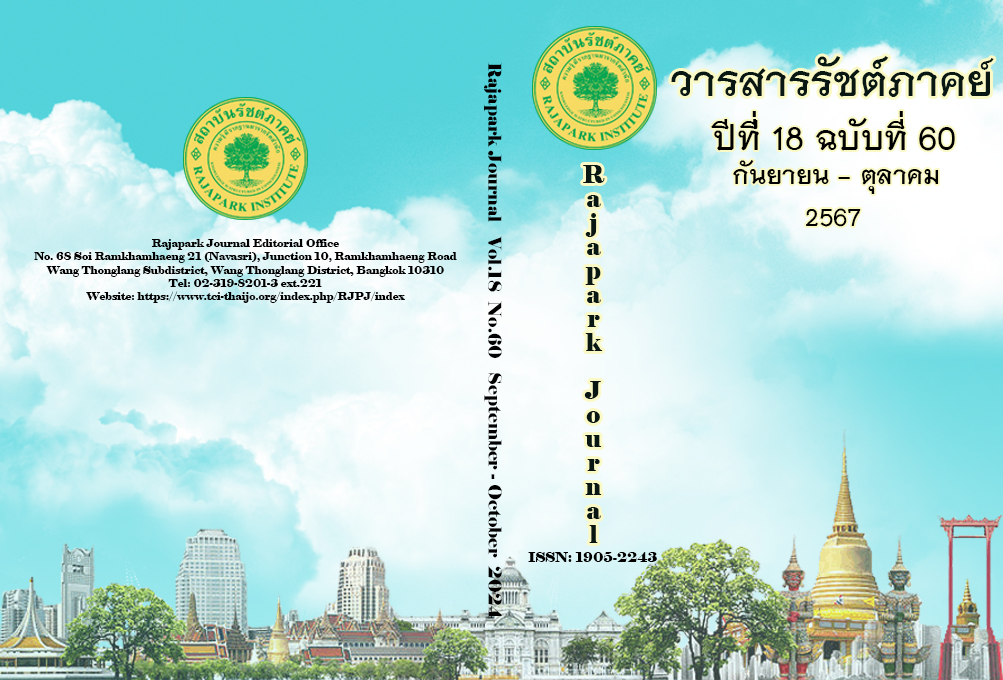Analysis of Firm Value, Financial Policy and Financial Flexibility: The Case of Companies Listed on the Stock Exchange of Thailand
Main Article Content
Abstract
This research aims to study and synthesize the effect of financial policy on financial flexibility, the effect of financial flexibility on firm values, and the effect of financial policy on firm values through financial flexibility. This research is quantitative. The selection of the sample is a purposive sampling by selecting only companies listed in the SET100 index between 2020 and 2022, excluding companies with incomplete data and companies in the financial industry group. Structural equation modeling (SEM) was used to analyze the data in the research. The research found that financial policy related to dividend payment had a positive association with financial flexibility, while cash holding and capital structure did not affect financial flexibility. Moreover, financial flexibility also did not affect firm value. Lastly, financial policy related to cash holding, capital structure, and dividend payment did not have an indirect effect on firm values through financial flexibility. This is because the debt level of the company is high; although the company can access capital sources, the company should not have more financing to maintain the financial stability of the company.
Article Details

This work is licensed under a Creative Commons Attribution-NonCommercial-NoDerivatives 4.0 International License.
Views and opinions appearing in the Journal it is the responsibility of the author of the article, and does not constitute the view and responsibility of the editorial team.
References
Bilyay-Erdogan, S. (2020). Does financial flexibility enhance firm value?. A comparative study between developed and emerging countries. Business: Theory and Practice, 21(2), 723-736. https://doi.org/10.3846/btp.2020.12680
Blau, B. M., & Fuller, K. P. (2008). Flexibility and dividends. Journal of Corporate Finance, 14(2), 133-152. https://doi.org/10.1016/j.jcorpfin.2008.02.003
Bliss, B. A., Cheng, Y., & Denis, D. J. (2015). Corporate payout, Cash retention, and the supply of credit: Evidence from the 2008–2009 credit crisis. Journal of Financial Economics, 115(3), 521-540. https://doi.org/10.1016/j.jfineco.2014.10.013
Choopool, J. (2019). Factors influencing on firm value of listed companies on the stock exchange of Thailand: set 100 evidence[Master’s independent study, Rajamangala University of Technology Thanyaburi]. http://www.repository.rmutt.ac.th/dspace/handle/123456789/3675
Chung, K. H., & Pruitt, S. W. (1994). A simple approximation of Tobin's Q. Financial Management, 23(3), 70-74. https://doi.org/10.2307/3665623
Denis, D. J., & McKeon, S. B. (2012). Debt financing and financial flexibility evidence from proactive leverage increases. The Review of
Financial Studies, 25(6), 1897–1929. https://doi.org/10.1093/rfs/hhs005
El-Ansary, O., & Hamza, H. F. (2022). The underlying mechanisms of the relationships between corporate financial policies and firm value: Flexibility and agency theory perspectives. Asia-Pacific Journal of Business Administration, 15(3), 440-465. https://doi.org/10.1108/APJBA-08-2021-0420
Farrukh, K., Irshad, S., Khakwani, M. S., Ishaque, S., & Ansari, N. Y. (2017). Impact of dividend policy on shareholders wealth and firm performance in Pakistan. Cogent Business & Management, 4(1), 1-11. https://doi.org/10.1080/23311975.2017.1408208
Gamba, A., & Triantis, A. (2008). The Value of Financial Flexibility. The Journal of Finance, 63(5), 2263-2296. https://doi.org/10.1111/j.1540-6261.2008.01397.x
Hang, M., Geyer-Klingeberg, J., Rathgeber, A. W., & Stöckl, S. (2021). Rather Complements than Substitutes: Firm Value Effects of Capital Structure and Financial Hedging Decisions. International Journal of Finance & Economics, 26(4), 4895-4917. https://doi.org/10.1002/ijfe.2045
Jensen, M. C., & Meckling, W. H. (1976). Theory of the firm: Managerial behavior, agency costs and ownership structure. Journal of Financial Economics, 3(4), 305-360. https://doi.org/10.1016/0304-405X(76)90026-X
Karim, S., & Ilyas, M. (2021). Foreign institutional investors and the contribution of cash and dividend to firm’s value. Managerial Finance, 47(3), 310-325. https://doi.org/10.1108/MF-11-2019-0568
Limjaroenrat, V. (2016). Firm-level Perspective of Thailand’s Low Investment Puzzle. PIER Puey Ungphakorn Institute for Economic Research, 42, 1-45. https://ideas.repec.org/p/pui/dpaper/42.html
Maneerattanarungrod, C. (2016). Capital structure affecting firm value[Doctoral Dissertation, Suranaree University of Technology]. http://sutir.sut.ac.th:8080/jspui/handle/123456789/7180
Mangesti Rahayu, S., Suhadak, & Saifi, M. (2020). The reciprocal relationship between profitability and capital structure and its impacts on the corporate values of manufacturing companies in Indonesia. International Journal of Productivity and Performance Management, 69(2), 236-251. https://doi.org/10.1108/IJPPM-05-2018-0196
Mihaela, T. B. (2012). Corporate finance theories. Challenges and trajectories. Management & Marketing, 7(2), 277-294. https://www.researchgate.net/publication/241757166_Corporate_finance_theories_Challenges_and_trajectories
Mirkhalili, T. A., & Mahmoudabadi, H. K. (2018). The effect of financial flexibility on financial behavior of companies listed in Tehran stock exchange. American Journal of Industrial and Business Management, 8(1), 143-155. https://doi.org/10.4236/ajibm.2018.81009
Modigliani, F., & Miller, M. H. (1958). The cost of capital, corporation finance and the theory of investment. The American Economic Review, 48(3), 261-297. https://www.jstor.org/stable/1809766
Modigliani, F., & Miller, M. H. (1963). Corporate income taxes and the cost of capital: A correction. The American Economic Review, 53(3), 433-443. https://www.scirp.org/reference/ReferencesPapers?ReferenceID=1363843
Myers, S. C. (1984). The capital structure puzzle. Journal of Finance, 39(3), 574-592. https://doi.org/10.1111/j.1540-6261.1984.tb03646.x
Myers, S. C., & Majluf, N. S. (1984). Corporate financing and investment decisions when firms have information that investors do not have. Journal of Financial Economics, 13(2), 187-221. https://doi.org/10.1016/0304-405X(84)90023-0
Phadungsit, M. (2005). Performance appraisal according to Tobin concept-Tobin's Q. Journal of Business Administration Faculty of Commerce and Accountancy Thammasat University, 28(106), 13-22. http://www.jba.tbs.tu.ac.th/files/Jba106/Article/JBA106Monvika.pdf
Phetkong, P., & Yupabhorn, B. (2019). The Relationship of Capital Structure on Firm Value and Profitability of Listed Companies in Market for Alternative Investment (MAI). Journal of Federation of Accounting Professions, 1(3), 62-81. https://so02.tci-thaijo.org/index.php/JFAC/article/view/225446
Rapp, M. S., Schmid, T., & Urban, D. (2014). The value of financial flexibility and corporate financial policy. Journal of Corporate Finance, 29, 288-302. https://doi.org/10.1016/j.jcorpfin.2014.08.004
The Stock Exchange of Thailand. (2020). Investment vocabulary. https://www.setinvestnow.com/th/glossary
The Stock Exchange of Thailand. (2022). Foreign companies. https://www.set.or.th/th/listing/equities/common-stocks/foreign-company/secondary-listing
Wonglacorn, S., & Am-ugsorn, S. (2023). Impact of corporate governance and financial flexibility on firm value in the covid-19 crisis: A case study of companies in the Stock Exchange of Thailand. Journal of Federation of Accounting Professions, 5(13), 20-41. https://so02.tci-thaijo.org/index.php/JFAC/article/view/260422


